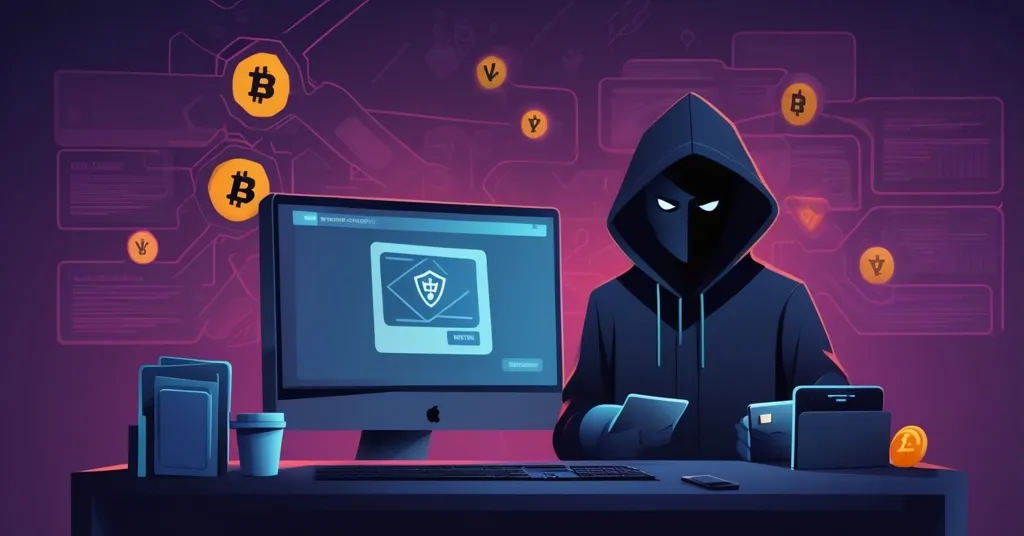CoinMarketCap Hit by ‘Verify Wallet’ Phishing Scam: Security Flaw Exposed and Fixed

CoinMarketCap Security Breach: ‘Verify Wallet’ Phishing Scam Exposed and Resolved
CoinMarketCap, the heavyweight of cryptocurrency data aggregation, recently stumbled into a security nightmare when a deceptive “Verify Wallet” popup surfaced on its website, aiming to dupe users into handing over control of their wallets through ERC-20 token approvals. This phishing scam, though swiftly addressed, raises serious questions about platform security in the crypto space.
- Malicious “Verify Wallet” popup targets users for wallet theft via phishing.
- CoinMarketCap removes the rogue code within three hours of detection.
- MetaMask and Phantom extensions flag the site, likely preventing widespread losses.
The Scam Explained: How It Targeted Crypto Wallets
Picture this: you’re browsing CoinMarketCap, checking the latest Bitcoin price or scouting an altcoin, when a popup titled “Verify Wallet” interrupts your flow. It nudges you to connect your wallet and approve transactions for ERC-20 tokens. For those new to the game, ERC-20 tokens are digital assets built on the Ethereum blockchain—think stablecoins like USDT or project-specific coins. They often require user permission for transactions, kind of like signing a blank check. If you’re not careful, approving such a request can let someone else drain your funds faster than you can say “private key.”
This particular popup, which appeared on a Friday—exact date unclear due to conflicting reports, with a questionable June 21, 2025 floating around as a likely typo—was a textbook phishing scam. Phishing in crypto is like a digital con artist knocking on your door, posing as a trusted friend to steal your keys. Here, the goal was clear: trick users into granting permissions that would allow hackers to siphon off tokens or access wallets entirely. Given CoinMarketCap’s massive daily traffic of millions of visitors, even a tiny fraction falling for this could spell disaster. While no specific loss figures have surfaced, the potential scope is chilling, as detailed in this security alert about the rogue wallet scam.
How does this play out in practice? You click “connect wallet,” thinking it’s a legit step. Next, a transaction approval screen pops up, often mimicking familiar interfaces like MetaMask. If you hit “approve,” you’ve just handed over the reins to your ERC-20 tokens. It’s a tactic we’ve seen before in scams targeting DeFi platforms, where complexity creates cracks for bad actors to exploit. And with no immediate clarity on how many users saw or interacted with this popup, we’re left guessing about the near-miss—or worse. If you’re curious about the mechanics of such attacks, check out this explanation of phishing scams targeting crypto wallets.
CoinMarketCap’s Response: Swift, But Is It Enough?
Credit where it’s due: CoinMarketCap didn’t drag their feet. Within roughly three hours of the issue being detected, their team identified and removed the malicious code from the site. They took to X with an update to calm the waters and outline next steps, as covered in this report on the malicious popup incident.
“Update: We’ve identified and removed the malicious code from our site. Our team is continuing to investigate and taking steps to strengthen our security.” — CoinMarketCap
Three hours is a blink in the tech world, especially when funds can vanish in minutes during a crypto heist. But let’s not hand out gold stars just yet. How the hell did this slip through in the first place? For a platform of this stature, serving as the go-to for price tracking and market data, such a lapse is borderline unforgivable. Was it a compromised third-party ad script, a flaw in their content management system, or something uglier like an insider slip-up? The silence on the root cause, coupled with a vague promise of “strengthening security,” leaves us hungry for a proper post-mortem. Until they spill the beans, trust takes a hit.
Community and Tech Safeguards: A Saving Grace
While CoinMarketCap scrambled, the broader crypto ecosystem showed its teeth. Popular wallet browser extensions MetaMask and Phantom stepped up, flagging the site as unsafe with glaring warnings splashed across users’ screens. These digital watchdogs likely stopped countless folks from clicking that fateful “approve” button. It’s a standing ovation moment for these tools, and you can read more about their role in warnings issued during the phishing incident. Relying on third-party apps to catch a major platform’s mess-up isn’t a sustainable fix, though. It’s like needing a neighbor to tell you your house is on fire because your smoke alarm failed.
Beyond tech, the community buzzed with alerts. On X and Reddit, users vented frustration over yet another hack attempt on a centralized service, with many preaching the gospel of cold storage—think hardware wallets like Ledger or Trezor that keep your keys offline and away from online traps. One Redditor even shared JavaScript snippets related to the breach for security researchers to dissect, proving the grassroots grit of this space. For a deeper dive into community reactions, see this Reddit discussion on the Verify Wallet scam. These layers of defense, from tech to human vigilance, blunted the attack’s impact, but they also highlight a glaring question: why are we still playing whack-a-mole with basic security on platforms this big?
Broader Implications: Crypto Security Under Fire
This isn’t CoinMarketCap’s first brush with cybercriminals. Rewind to October 2021, and they suffered a massive data breach exposing over 3.1 million user email addresses, later found circulating on hacking forums as flagged by Have I Been Pwned. That incident didn’t hit wallets directly, but it eroded trust and likely fueled targeted phishing down the line. Now, with this popup scam aiming straight for funds, we’re seeing hackers up their game. For a comparison to past incidents, check out these Reddit discussions on the 2021 email leak and recent scam. It’s a stark escalation, and it feeds into a larger trend of rising phishing attacks across the crypto sector, especially as DeFi’s growth widens the playground for digital bandits.
As a centralized hub, CoinMarketCap wields immense influence, guiding millions through the maze of blockchain markets. When trust in such a platform wavers, it ripples outward, fueling skepticism about centralized services altogether. Many in the community are doubling down on calls for decentralized alternatives—think self-hosted price trackers or peer-to-peer data tools—though those often come with a steep learning curve. For background on the platform itself, you can refer to this overview of CoinMarketCap. It’s a tension at the heart of crypto: the convenience of centralized platforms versus the sovereignty of going full DIY. Breaches like this tip the scale toward the latter, but only if users are ready to step up.
Bitcoin’s Edge and the Altcoin Tradeoff
From a Bitcoin maximalist lens, there’s a quiet smirk to be had. Bitcoin’s design keeps things brutally simple—no token approvals, no smart contract labyrinths like Ethereum’s ERC-20 ecosystem. You control your keys, you control your coins. End of story. Scams like this popup thrive on the complexity of altcoin systems, where one wrong click can sign away your stash. That said, let’s not get drunk on BTC purism. Ethereum and other blockchains power incredible innovation—DeFi protocols, NFTs, and beyond—that Bitcoin isn’t built to handle. They fill niches critical to this financial upheaval, but the price is risk. Incidents like this underscore why education and caution must match the tech’s ambition, no matter the chain you ride with.
Effective Accelerationism: Pain as Progress?
Here’s a hard pill to swallow: breaches suck, but they can spark change. Call it effective accelerationism—the idea that pain today fuels innovation tomorrow. The swift flags from MetaMask and Phantom, paired with community outcry on social media, show the crypto ecosystem’s knack for self-correction. Think back to the 2014 Mt. Gox hack; it was a gut punch, but it birthed better exchange security and wallet standards. This CoinMarketCap fiasco could push platforms to adopt ironclad measures—real-time script scans, multi-factor code checks—and nudge users toward safer habits. Still, there’s a flip side: repeated screw-ups risk scaring off newcomers faster than innovation can rebuild trust. Adoption isn’t a given if every week brings a new horror story. Pain can inspire, but it can also paralyze.
How to Protect Your Crypto Wallet from Phishing Scams
Enough dissection—let’s talk defense. Crypto’s promise of financial freedom means nothing if you don’t guard it like a hawk. Here’s how to shield yourself from phishing traps like this one, broken down for both newbies and grizzled OGs. For a comprehensive guide, take a look at these crypto security best practices against phishing attacks.
- Double-Check Everything: Before connecting a wallet, scrutinize the URL. Scammers often use lookalike domains (think “C0inMarketCap” with a zero). Bookmark trusted sites to avoid typos.
- Ignore Unsolicited Prompts: If a popup or email asks for wallet access out of nowhere, treat it like a stranger asking for your house key. Close it, clear your cache, and report it.
- Use Cold Storage: Hardware wallets keep your keys offline, untouchable by online scams. They’re not foolproof, but they’re a damn good fortress.
- Enable 2FA: Two-factor authentication on accounts linked to your crypto adds a layer, though it won’t stop wallet approval scams directly—still worth it.
- Lean on Security Tools: Browser extensions like MetaMask often warn of dodgy sites. Keep software updated for the latest threat detection.
Paranoia is your friend here. Crypto isn’t a game of trust—it’s a battlefield of vigilance. One click can wipe you out, so act like every prompt is a loaded gun.
Key Takeaways and Questions for Reflection
- How did the “Verify Wallet” phishing scam on CoinMarketCap operate?
It lured users into connecting wallets and approving ERC-20 token transactions, potentially granting hackers access to drain funds through exploited permissions. - How quickly did CoinMarketCap react to the security breach?
They identified and removed the malicious code within about three hours, a fast response that likely curbed damage, though root causes remain unclear. - What role did MetaMask and Phantom play in user protection?
These wallet extensions flagged the site as unsafe with immediate warnings, acting as a vital shield that probably saved many from financial loss. - What does this incident reveal about crypto security risks?
It exposes how phishing scams prey on trust in major platforms, amplified by DeFi’s complex mechanisms that create more opportunities for hacker exploits. - How can users safeguard against similar crypto wallet scams?
Stay skeptical of unexpected prompts, use hardware wallets for offline storage, double-check URLs, enable 2FA, and rely on security tools for threat alerts.
Looking Ahead: Trust and Transparency
So, where does this leave us? CoinMarketCap owes its users more than a quick fix and a pat on the back. A detailed breakdown of how this popup infiltrated their defenses—and what hard, actionable steps they’re taking beyond “investigating”—is non-negotiable. For the rest of us, it’s a slap-in-the-face reminder that even the biggest names in crypto aren’t bulletproof. The promise of decentralization, privacy, and financial sovereignty hinges on unrelenting caution. Stay sharp, guard your sats, and never trust a popup—your role in this revolution demands it.



